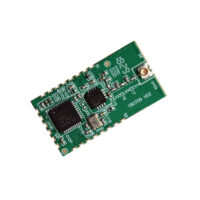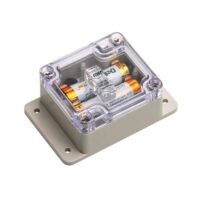popularization of knowledge
RFID system introduction: RFID tags and readers work principle
发表于 知识科普 |
What is an RFID system?
RFID (Radio Frequency Identification) system is a technology for automatic identification and data capture through radio waves. The system mainly consists of two parts: RFID tags and readers.RFID system can realize fast and efficient identification and tracking without touching the object, and is widely used in the fields of warehousing and logistics, supply chain management, healthcare, retail and so on.
How RFID tags work
RFID tags are the core component of an RFID system, usually consisting of an antenna and a chip. Based on their power supply, RFID tags are categorized into passive and active tags.
1. Passive labeling:
- How it works:Passive tags have no internal power supply; they gain energy by capturing the RF signal from the reader and then use that energy to activate the chip and send the information.
- signal transmission: When a passive tag enters the electromagnetic field of a reader, the tag's antenna receives the RF signal and converts it into electrical energy to activate the chip. The tag then reflects the stored information back to the reader through backscatter technology.
- application scenario: Due to the low cost and small size of passive tags, they are suitable for applications requiring proximity identification such as logistics, retail and access control systems.
2. Active labeling
- How it works:Active tags have a built-in battery that actively sends signals to the reader, resulting in longer read ranges.
- Signaling:Active tags periodically send signals, and the reader receives these signals and reads the information on the tag.
- Application Scenarios:Active tags are suitable for applications that require long-range identification, such as vehicle management, asset tracking and environmental monitoring.
How RFID readers work
RFID readers are responsible for communicating with RFID tags to read or write tag information. Its working principle is as follows:
- Signal emission:
o The reader transmits RF signals through the antenna, creating an electromagnetic field.
o This electromagnetic field is used to activate the passive tag and communicate with the active tag. - Information received:
o The tag enters the electromagnetic field of the reader, is activated and sends the information.
o The reader receives the RF signal from the tag and converts it to digital information. - Data processing:
o The reader transmits the received tag information to the backend system for further processing and analysis to realize the identification and tracking of items.
RFID bands and their applications
RFID systems can be categorized into four types according to the different frequency bands: Low Frequency (LF), High Frequency (HF) and Ultra High Frequency (UHF) and Microwave. Each frequency band has different application scenarios and characteristics:
- Low Frequency (LF):Frequency band from 30 kHz to 300 kHz, commonly used frequencies are 125 kHz and 134.2 kHz. suitable for close range (<0.5 m) identification, e.g. animal identification and access control.
- Characteristics: strong penetration, good adaptability to metal and water, low transmission rate.
- High Frequency (HF):The frequency band is from 3 MHz to 30 MHz, and the commonly used frequency is 13.56 MHz. applications in library management, e-ticketing and smart card systems.
- Characteristics: reading distance is generally between 10 cm and 1 meter, moderate transmission rate, strong anti-interference ability.
- Ultra High Frequency (UHF):Frequency bands from 300 MHz to 3 GHz, with common frequencies from 860 MHz to 960 MHz. widely used in supply chain management, warehousing and logistics, and retail.
- Features: Longer reading distance (1 meter to 12 meters), high transmission rate, but more sensitive to metal and liquid environments.
- Microwave:The frequency bands are 2.4 GHz to 2.5 GHz and 5.8 GHz. The main applications are highway ETC systems and vehicle identification.
- Characteristics: long reading distance, high transmission rate, but easily affected by the environment.
SO/IEC standards
ISO/IEC 18000 series: This is a set of standards defining air interface protocols for RFID technology, covering RFID systems in different frequency bands:
- o ISO/IEC 18000-1:Basic Definition of RFID Air Interface
o ISO/IEC 18000-2:Low Frequency (LF) band (below 135 kHz)
o ISO/IEC 18000-3:High Frequency (HF) band (13.56 MHz)
o ISO/IEC 18000-4:Microwave band (2.45 GHz)
o ISO/IEC 18000-6:Ultra-high frequency (UHF) band (860-960 MHz)
o ISO/IEC 18000-7:433 MHz band
Benefits of RFID systems
- Non-contact identification:RFID technology does not require physical contact to identify items, increasing ease and speed of operation.
- Quick Read:The reader can read information from multiple RFID tags at the same time, greatly improving identification efficiency.
- Recognition at a distance:Active tags, in particular, can recognize distances of tens of meters or more.
- High environmental resistance:RFID tags can be encapsulated in a variety of materials, adapt to harsh environments and have high durability.
Application Scenarios for RFID Systems
- Warehouse logistics:RFID technology is used for automatic identification of goods and inventory management to improve warehousing efficiency and accuracy.
- Supply Chain Management:Realize instant tracking and management of all aspects of the product from production to sales.
- Medical field:Patient identification, drug tracking, medical device management, etc.
- Retail:Merchandise anti-theft, inventory management and automatic billing.
- Transportation:Vehicle identification, electronic toll collection and intelligent traffic management.
reach a verdict
The RFID system has been widely used in several industries due to its high efficiency, reliability and convenience. Understanding the working principle of RFID tags and readers, as well as the application scenarios of different frequency bands, helps us to better utilize this technology and enhance the management and operation efficiency in various application scenarios.
RFID Products 🛒
-
 Active RFID tag reading module Customize your own reader to locate base station IPX antenna interface WE-RM01¥78
Active RFID tag reading module Customize your own reader to locate base station IPX antenna interface WE-RM01¥78 -
 Active RFID 433 to Ethernet Network Reader WE-RWN02¥1,024
Active RFID 433 to Ethernet Network Reader WE-RWN02¥1,024 -
 Active RFID 485 to Ethernet Network Reader Base Station WE-RN01¥585
Active RFID 485 to Ethernet Network Reader Base Station WE-RN01¥585 -
 Active RFID 485 Reader Base Station WE-RU01¥450
Active RFID 485 Reader Base Station WE-RU01¥450 -
 Active RFID Personnel Item Location Tag WE-T30¥43
Active RFID Personnel Item Location Tag WE-T30¥43

Content Reviewer:Mick Weng









